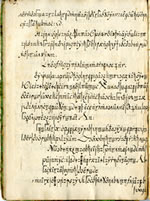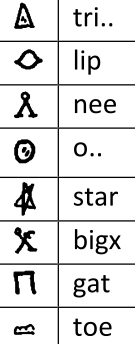 A team of linguists from Uppsala University in Sweden and a computer scientist from the University of Southern California have cracked the Copiale Cipher, an 18th century coded manuscript, using statistics-based translation techniques seen in programs like Google Translate.
A team of linguists from Uppsala University in Sweden and a computer scientist from the University of Southern California have cracked the Copiale Cipher, an 18th century coded manuscript, using statistics-based translation techniques seen in programs like Google Translate.
 The Copiale Cipher is a 105-page manuscript written in a code of 90 different characters. The characters include Roman and Greek letters, symbols and diacritical marks and there are approximately 75,000 of them in the book. The paper is high quality and the manuscript is gloriously bound in green and gold brocade. There are two notes that are not in code: “Philipp 1866” on the first page, thought to be an owner’s mark, and “Copiales 3” at the end of the last page. We don’t know what Copiales means but they named the book after it anyway.
The Copiale Cipher is a 105-page manuscript written in a code of 90 different characters. The characters include Roman and Greek letters, symbols and diacritical marks and there are approximately 75,000 of them in the book. The paper is high quality and the manuscript is gloriously bound in green and gold brocade. There are two notes that are not in code: “Philipp 1866” on the first page, thought to be an owner’s mark, and “Copiales 3” at the end of the last page. We don’t know what Copiales means but they named the book after it anyway.
Dating back to between 1760 and 1780, the Copiale Cipher was discovered in the archive of the East Berlin Academy in the former East Germany after the Cold War. It’s owned by a private collector now, but the team were given full access to it this year. USC computer scientist Kevin Knight, and Uppsala University linguists Beáta Megyesi and Christiane Schaefer decided to collaborate as a weekend project to see if they could decipher the code.
They began assuming the Roman and Greek letters were the real text. They didn’t know the original language the code would translate to, however, and after trying 80 languages with no luck, they realized that the Roman and Greek letters were NULLS, intended to trick prying eyes and serve as spaces between the real words which were all composed of symbols.
[T]hey figured that the code was what cryptographers call a homophonic cipher — a substitution code that does not have a straightforward correspondence between the original and encoded information. And they decided the original language was probably German. […] Another crucial discovery was that a colon indicated the doubling of the previous consonant.
The researchers used language-translation techniques like expected word frequency to guess what a symbol might equal in German.
“It turned out that we can apply a lot those techniques to code breaking,” Dr. Knight said.
As the symbols revealed themselves as German letter combinations, the researchers found the text peppered with the kind of phrases you hope to find in a coded 18th century manuscript, like “ceremonies of initiation” and “secret section.” The team finished translation the first 16 pages of the manuscript and the Copiale Cipher turns out to be the top secret ritual book of a secret society fixated on ophthalmology and eye surgery.
 There are eight characters larger in size than all the others which appear to refer to illustrious personages in the secret society and have no translation. They are double secret, if you will. The team assigned them a transcription scheme (key to the right) which is used in the translation (pdf file).
There are eight characters larger in size than all the others which appear to refer to illustrious personages in the secret society and have no translation. They are double secret, if you will. The team assigned them a transcription scheme (key to the right) which is used in the translation (pdf file).
The conducting *nee* speaks thereupon to the ceremony *nee*: ” Hereby I pass to the brother the candidate in body and soul, so that he sees if “one cannot help his weak face with an operation. He carries him thereafter to a secondary table where, next to a lot of candles, several instruments and eye glasses, microscopic perspective, a cloth and a glass of water must be present. He has to lower himself on to a tabouret and to look upon an unwritten piece of paper for a while. If, after a while, he answers that he cannot see anything written on there, than the master of ceremonies puts him a pair of eye glasses and asks him again if he is not able to read the writing. Answer no. During this time the master of ceremonies comforts him as good as he can, raises his hopes
for improvement washes his eyes with a cloth and if nothing helps, he will announce that they have to proceed with the operationthen all those present members reach for the candles place themselves around the candidate and the master of ceremonies *nee* plucks a hair from the eyebrow with a pair of small tweezers under constant urging, comfort and encouragement and concludes herewith the operation
So it’s sort of social. Demented and sad, but social.
I know it may seem a tad on the lame side as far as secret rituals of secret societies go, but Knight showed the text to Andreas Onnerfors, a Swedish historian who is an expert on secret societies, and he found a reference to the natural rights of man, a recurring theme in the 18th century where secret societies played a significant role in the fraught politics of Revolutionary France and America.
To read about the decryption adventure in detail, see Kevin Knight, Beáta Megyesi and Christiane Schaefer’s paper The Copiale Cipher (also a pdf).
“The conducting *nee* speaks…” You don’t suppose this has anything to do with “The Knights who say ‘Nee!’ “?
Oh, what sad times are these when passing ophthalmology-obsessed weirdos can say “nee” at will to old ladies.
Awesome article. Very well written and informative.
Thank you.
Was the eyebrow hair plucking the whole of the “operation”?
the Copiale Cipher turns out to be the top secret ritual book of a secret society fixated on ophthalmology and eye surgery.
This is the awesomest reveal ever
The eyebrow hair plucking is the whole of the “operation” at that point, yes. Perhaps there’s some sort of follow-up eyelash surgery on one of the pages that haven’t been translated yet.
You mean the knights who until recently said “nee”.
…and the Copiale Cipher turns out to be the top secret ritual book of a secret society fixated on ophthalmology and eye surgery.
Can a new Dan Brown novel be far behind?
I sure do hope so.
LOL, they’re talking “operation” with all this ritual, so I am expecting silver daggers and blessed towels and blindness, and I get eyebrow grooming.
Too awesome.
I just gave myself some surgery this morning standing in front of the bathroom mirror!1
Super necro-posting, but I ran across this article on the cracking of the cipher today, and it helps fill in some of the context for this group, as it seems possible it was this funky cover group to pass on Mason rituals in the guise of spying on them. http://www.wired.com/dangerroom/2012/11/ff-the-manuscript/